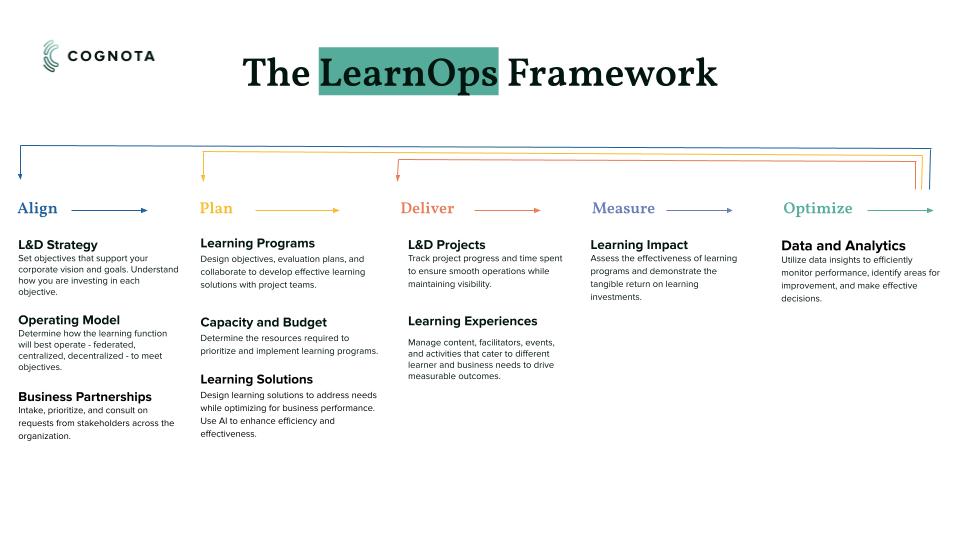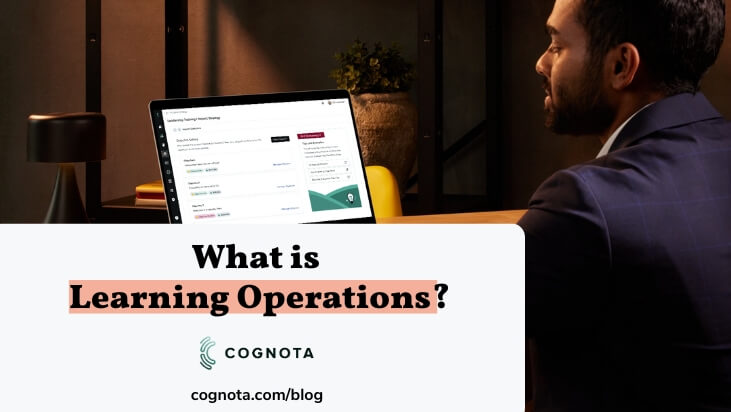As corporate learning and development (L&D) evolves, so does the need for a more strategic approach to training. Learning operations, or LearnOps, offer a comprehensive framework that integrates planning, execution, and measurement of L&D initiatives with organizational goals. This approach transforms L&D from a series of isolated activities into a cohesive, impactful strategy that drives business performance and growth. Dive into the essentials of LearnOps and discover how it can elevate your organization’s training programs to new heights.
Just as DevOps emerged as a way to tighten the management of software development across the enterprise and RevOps to seek efficiencies across the teams responsible for driving the organization’s revenue, LearnOps is a new paradigm that has emerged to ensure the L&D function is operating as efficiently and strategically as possible, in lockstep with business goals.
What are learning operations?
Learning operations refer to the processes, methods, and practices leveraged by learning and development teams to plan, manage, deliver and measure learning programs. It encompasses the methodologies, processes, tools, and technologies used to enhance the efficiency and effectiveness of corporate training programs.
The “LearnOps” framework is a strategic and systematic approach designed to optimize the planning, execution, and measurement of an organization’s learning and development (L&D) initiatives.
According to LinkedIn Learning’s 2024 Workplace Learning Report, aligning learning programs to business goals was the top L&D goal of 2024.
At its core, LearnOps aims to align L&D activities closely with business goals, ensuring that learning interventions are not only impactful but also measurable in terms of their contribution to organizational performance and growth. This discipline signifies a shift from ad-hoc training efforts to a cohesive operational model that fosters continuous learning, agility, and adaptation within the corporate ecosystem.

Benefits of Enhanced Learning Operations
Improvements to learning operations ensures L&D runs like an efficient, data-driven business with performance at the core of every strategic decision and resource allocation.
Benefits of learning operations include:
- Strategic alignment, as learning program objectives are integrated with business goals for impactful outcomes.
- Creation of partnerships between L&D and key stakeholders across the organization instead of training existing as a silo, enabling L&D to act as performance consultants rather than ordertakers.
- Operational efficiency, because processes are streamlined and the time and resources needed to maintain or increase input are reduced.
- Innovative approaches, by creating a holistic learning ecosystem and “culture of learning” that can develop and deliver training as needed,
- Measurable impact, as learning effectiveness can be directly linked to organizational performance.
Learning Operations Vs Training Operations
The terms Learning Operations and Training Operations might seem interchangeable, but they are actually quite different.
Training operations traditionally focuses on the logistical aspects of delivering training programs, typically instructor-led sessions. It involves scheduling, coordinating instructors and resources, managing enrollments, collecting assessments, and ensuring the smooth execution of training sessions.
The emphasis is on the operational efficiency of delivering predefined training content to learners, often within a set timeframe; training operations typically do not concern a direct, measured linkage to broader organizational goals beyond the immediate scope of skill acquisition or compliance.
Learning operations, on the other hand, represents a holistic approach that not only encompasses the logistical execution aspects covered by training operations but also integrates these activities within a strategic framework that aligns with the organization’s broader objectives.
LearnOps is characterized by its focus on the entire lifecycle of learning within an organization, including the alignment of learning programs with corporate vision and goals, the planning and design of learning programs based on strategic priorities,the maximization of L&D resources and operational processes, the delivery of these programs and learning experiences in a manner that maximizes learner engagement and impact, and the measurement and optimization of learning outcomes to ensure they contribute value to the organization.
Key differences include:
- Strategic alignment: Unlike Training Operations, which may operate in a silo, LearnOps ensures that learning and development is closely aligned with the organization’s strategic objectives, facilitating a more significant impact on performance and growth.
- Measurement and optimization: LearnOps places a strong emphasis on measuring the effectiveness of learning initiatives and using these insights to continuously optimize learning strategies for better alignment with business outcomes.
- Goals and objectives: The objectives of Training Operations are to train employees for a particular skill or body of knowledge; assessments afterward are simply whether the employee retained that knowledge. In LearnOps, the goal is not just a trained employee but a measurable impact on business processes across the organization.
- Stakeholder engagement: LearnOps involves active collaboration and consultation with stakeholders across the organization to ensure learning initiatives are relevant, timely, and supportive of both learners and the overall business.
In short, while Training Operations address the logistics and execution of training programs, LearnOps elevates the role of L&D by embedding it within the strategic fabric of the organization.
What is the role of learning and development operations?
The role of learning and development operations within an organization is increasingly demonstrating an ability to deliver strategic growth and operational excellence. Because LearnOps integrates L&D initiatives with the broader objectives of the organization, LearnOps holds a position across several critical business processes:
Strategic Alignment
LearnOps ensures that learning and development efforts are not isolated activities but are deeply integrated with the company’s strategic goals. It aligns L&D projects with business objectives, ensuring that every learning initiative contributes to overarching corporate visions, such as enhancing competitiveness, fostering innovation, and supporting organizational change.
Efficiency and Scalability
By optimizing L&D processes, LearnOps improves the efficiency of delivering learning programs. It streamlines workflows, leverages technology for automation, and ensures that resources are allocated judiciously, making learning initiatives scalable and adaptable to the changing needs of the organization.
Measurement and Impact Analysis
A core role of LearnOps is to measure the effectiveness and impact of learning initiatives. Through robust data analytics and impact measurement tools, LearnOps assesses how learning programs contribute to individual performance, team effectiveness, and business outcomes, enabling continuous improvement and justification of L&D investments.
Stakeholder Engagement
LearnOps serves as a bridge between L&D and other departments, ensuring that learning initiatives meet the needs of various stakeholders. It involves consulting with department heads, understanding employee learning needs, and aligning L&D strategies to support the entire organization’s performance objectives.
Future-Proofing the Organization
By focusing on skills development and adaptability, LearnOps prepares the workforce for future challenges. It anticipates skill gaps and market trends, ensuring that the organization remains competitive in an ever-evolving business landscape.
Catalyst for L&D Transformation
LearnOps serves as the critical catalyst that transforms the Learning and Development function from being perceived as merely an order-taker to becoming a strategic driver within the organization. This shift is accomplished by proactively identifying business challenges and leveraging L&D as a solution to address them, rather than passively responding to training requests.
By aligning learning initiatives with strategic business outcomes, LearnOps elevates the status of L&D, positioning it as a key contributor to the organization’s success. This strategic approach enables L&D to not only fulfill immediate training needs but also to anticipate future trends, prepare the workforce for upcoming changes, and support the organization’s growth and innovation goals. Through LearnOps, L&D transitions into a vital strategic partner that proactively shapes and drives the organization’s learning culture, ensuring that learning becomes a continuous, integral part of achieving business objectives and enhancing organizational performance.
In summary, the role of LearnOps is to strategically manage and optimize learning and development operations in alignment with business goals. It transforms L&D from a support function into a strategic partner that drives organizational success and empowers employees to achieve their full potential.
How to Develop a Learning Operations Strategy in 2024
Developing a LearnOps strategy is relatively straightforward, and leans heavily on business processes and strategies that you may already have in place within your organization. Some of these elements may need more attention than others, and keep in mind that this is not a linear process. For example, your organization might wish to build in measurement and assessments at every step of the way.
Each of these steps is itself a strategy, and may already exist in some form within your L&D department or organization. Mindful of time and resources, LearnOps is supposed to yield efficiency, not reinvent the wheel.
1. Align
Garner a complete understanding of the goals of the team, department, or division needing training, and ensure that they are aligned with larger organizational goals.
2. Plan
With a thorough understanding of goals and their alignment, L&D teams can more confidently and efficiently prioritize capacity, budgets, and resources needed for the training.
Planning can include evaluating the capabilities of both insourced and outsourced L&D team members, access to design, development, and assessment tools, and a rough estimate of time needed to complete the learning project.
3. Deliver
Delivery can mean several things: delivery of initial prototypes of a course; delivery of the actual training modules to learners; delivery of final assessments; delivery of results to management; or a combination of any of these along the way.
Delivery requires transparency of project timelines and operations, and is often dependent on the resources and preferences of the teams involved. It is imperative that learning leaders manage the learning content and activities that meet diverse learning needs for business partners across any size organization.
4. Measure
Assessing the effectiveness of all aspects of learning development is critical for program success. While business managers are keenly interested in measuring whether knowledge or skills were acquired, L&D professionals can measure so many touchpoints along the way, including internal assessment during the design and development process up through capturing data points that prove the training improved the company’s profitability.
The ability to demonstrate the tangible return and impact of learning investments is critical to a LearnOps program.
5. Optimize
“If you can’t measure it, you can’t improve it,” Peter Drucker, the “father” of modern management theory, was fond of saying.
As such, analyze data insights to monitor L&D efficiency and effectiveness to quickly identify areas for improvement. However, you should also absolutely point to your learning team’s successes and celebrate wins! You and your team have worked hard.
Seize the LearnOps moment
As the learning and business landscapes evolve, Cognota and LearnOps are ready to transform your teams and processes.
Traditional methods no longer suffice: LearnOps will give you and your organization a competitive edge.
Adapt and scale: Market demands can change quickly, and L&D needs the ability to adapt, change, and scale quickly.
Maximize impact: Traditional processes won’t work in rapidly changing environments Optimize L&D operations to make the most out of your resources and ensure impact across the organization.
Futureproof your team: Embracing LearnOps equips your team, processes, and resources as new challenges and opportunities arise.
Book a demo today to see LearnOps in action for yourself!





